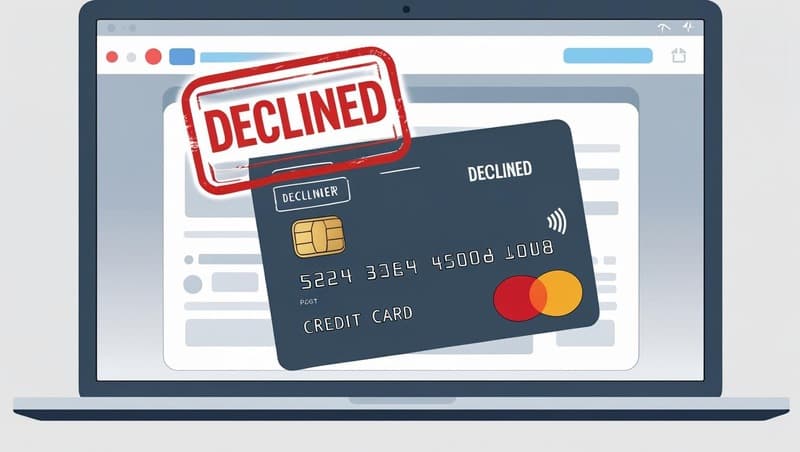Understanding Involuntary Churn: Your Silent Revenue Killer
Involuntary churn is a silent killer for SaaS businesses, eroding revenue without warning. Learn how to identify the causes of involuntary churn, such as payment failures, and implement effective dunning management strategies to reduce churn and protect your recurring revenue.

Understanding Involuntary Churn
Churn is the most important metric that all software companies need to monitor. While most companies care about voluntary churn (when customers actively cancel), there's another type of churn that can have a major impact on revenue: involuntary churn.
This post will unpack what involuntary churn is, why it's so critical for your lean business to address, and how to combat it effectively.
What is Involuntary Churn?
Involuntary churn happens when a customer's subscription or service terminates for reasons outside their intentional desire to cancel. Unlike voluntary churn, which happens because of dissatisfaction or a perceived lack of value, involuntary churn is typically caused by failed payments.
This is the typical scenario: a customer loves your service or product, uses it regularly, and has no intention of leaving. But then, their credit card expires, their bank flags a transaction, or there aren't enough funds. Without proper systems, their subscription quietly lapses, and you lose a valuable customer.
The Hidden Cost: Why Involuntary Churn is Your Silent Revenue Killer
The "silent" nature of involuntary churn impacts software companies of all sizes. You might misattribute these losses to voluntary reasons, failing to pinpoint the real cause and implement effective solutions. This leads to:
Undermined Revenue Growth: Every involuntarily churned customer means lost recurring revenue. These small, silent losses compound quickly.
Wasted Acquisition Costs: You've already invested time and money acquiring these customers. Losing them to preventable issues means that acquisition cost was essentially wasted.
Damaged Customer Relationships: Even unintentional, a payment failure can be frustrating. If not handled swiftly and empathetically, it can sour their perception of your brand.
Skewed Data and Misguided Strategies: If you're not accurately distinguishing between voluntary and involuntary churn, your retention efforts will be misinformed, tackling the wrong problems.
While overall churn rates vary, industry data from leading subscription platforms like Recurly indicates that involuntary churn can account for a significant portion, with a reported average of 0.86% across industries in their 2023 benchmarks, and even lower for specific sectors like SaaS at a median of 0.67%. Even these seemingly small percentages can translate into substantial lost revenue over time.
Common Causes of Involuntary Churn
To effectively combat involuntary churn, you need to understand its primary culprits:
Expired Credit Cards: The most common cause. Cards have expiration dates, and customers often forget to update their info.
Insufficient Funds: A customer might have temporary cash flow issues, leading to a declined transaction.
Payment Gateway Issues: Technical glitches or communication problems between your payment processor and the customer's bank.
Fraud Flags: Banks might flag legitimate transactions as potentially fraudulent.
Lost or Stolen Cards: When a customer's card is compromised, it's canceled, and recurring payments tied to it will fail.
Billing Information Errors: Simple typos in card numbers, addresses, or security codes can lead to failed transactions.
Combatting Involuntary Churn: Strategies for Retention
The good news is that involuntary churn is largely preventable. By implementing proactive strategies, you can significantly reduce its impact:
1. Robust Dunning Management
Automated Payment Retries: Don't give up after the first failed attempt. Implement a smart retry logic that tries payments again at optimal times (e.g., different days, different times).
Timely and Empathetic Communication: When a payment fails, notify the customer immediately through multiple channels (email, SMS, in-app messages). The tone should be helpful and understanding, not accusatory. Provide clear instructions on how to update their information.
Personalized Reminders: Tailor messages based on the reason for the failed payment if identifiable.
Clear Call-to-Actions: Make it incredibly easy for customers to update their payment details via a secure, user-friendly portal.
2. Proactive Card Expiry Notifications
Don't wait for a payment to fail. Send automated reminders to customers well in advance of their card's expiration date, prompting them to update their information.
3. Offer Multiple Payment Methods
Provide a variety of payment options (credit/debit cards, digital wallets, bank transfers) to increase the likelihood of successful transactions and cater to customer preferences.
4. Leverage Automatic Card Updaters (ACUs)
Many payment processors, like Stripe, offer ACU services that automatically update expired or reissued card details, often without customer intervention. This is a powerful tool for preventing churn.
5. Enhanced Customer Support for Billing Issues
Ensure your support team is well-trained to handle billing inquiries with empathy and efficiency. Easy access to human support can turn a potentially churned customer into a loyal one.
6. Analyze and Learn from Data
Regularly analyze your involuntary churn data. Identify common causes, peak times for failures, and segments most affected. This data will inform and refine your prevention strategies.
The Bottom Line
Involuntary churn can meaningfully affect your revenue, and is often overlooked but easily mitigated. Every customer counts, and preventing these unintentional losses is crucial for sustainable growth. By understanding its causes and implementing proactive strategic from smart dunning management to leveraging automatic card updaters you can significantly improve your customer retention and secure your recurring revenue streams.
Don't let involuntary churn erode your hard-earned revenue. Address it head-on, and watch your business thrive.
Ready to Eliminate Your Silent Revenue Killer?
Understanding involuntary churn is the first critical step; tackling it effectively is the next.
If you're looking for a powerful, automated solution to proactively recover lost revenue, increase customer lifetime value, and turn payment failures into successful retentions, ChurnDog is designed precisely for that.
Discover how ChurnDog can automatically recover your lost revenue and optimize your subscription billing. Start your free ChurnDog trial.
Want to read more about churn prevention and revenue recovery?
Back to all blog posts